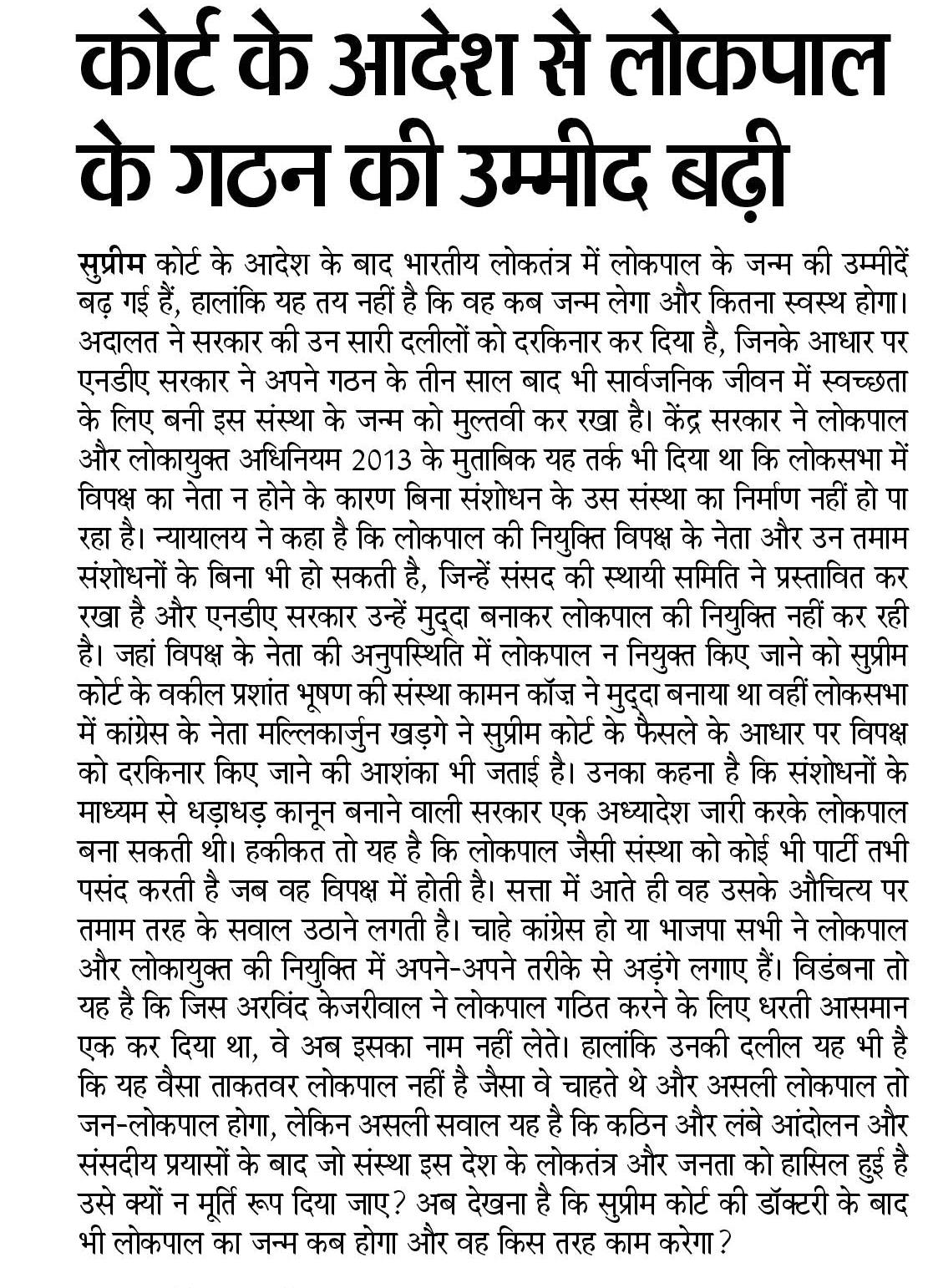
29-04-2017 (Important News Clippings)
To Download Click Here.
लोकपाल का इंतजार
आखिरकार लोकपाल की नियुक्ति के मामले में सर्वोच्च अदालत के कठोर रुख ने सरकार की हीलाहवाली की हवा निकाल दी है। अदालत ने फैसला सुनाया है कि लोकपाल अधिनियम में बिना किसी संशोधन के ही काम किया जा सकता है। दरअसल, अदालत इस बात से नाराज थी कि लोकपाल की नियुक्ति को क्यों अधर में रखा गया है। गौरतलब है कि लोकपाल की नियुक्ति में देरी को लेकर स्वयंसेवी संगठन कॉमन कॉज ने याचिका दायर कर रखी थी। देरी का कारण सरकार यह बताती रही कि नियुक्ति समिति की शर्त पूरी नहीं हो पा रही है। लोकपाल की नियुक्ति या चयन के लिए जो समिति गठित की जानी है उसके सदस्यों में लोकसभा में नेता-प्रतिपक्ष का भी प्रावधान है, जबकि मौजूदा लोकसभा में कोई नेता-प्रतिपक्ष नहीं है। कांग्रेस चौवालीस सदस्यों के साथ लोकसभा में विपक्ष की सबसे बड़ी पार्टी जरूर है, पर सदन में उसके नेता मल्लिकार्जुन खरगे नेता-प्रतिपक्ष नहीं हैं। उन्हें नेता-प्रतिपक्ष मानने की कांग्रेस की अपील लोकसभा अध्यक्ष ने खारिज कर दी थी। लेकिन केंद्र सरकार के इस तर्क या स्पष्टीकरण से सर्वोच्च न्यायालय संतुष्ट नहीं था।
कोई चार महीने पहले ही सुनवाई के दौरान उसने कहा था कि अगर नेता-प्रतिपक्ष से संबंधित समस्या दूर नहीं हो रही है तो न्यायालय आदेश दे सकता है कि संसद में सबसे बड़ी विपक्षी पार्टी का नेता ही नेता-प्रतिपक्ष होगा। और अब तो न्यायालय ने यह तक कह दिया कि लोकपाल अधिनियम में बिना संशोधन के ही काम किया जा सकता है। दरअसल, अगर सरकार का इरादा टालमटोल का न होता, तो नेता-प्रतिपक्ष की परिभाषा में ढील देने के लिए आवश्यक संशोधन कब का पारित हो चुका होता। अगर इस मामले में कोई संशोधन विधेयक लाया जाता, तो विपक्ष उसका तहेदिल से स्वागत ही करता। पर जो कानून 2013 में पारित हो चुका और जिसे भाजपा ने भी दोनों सदनों में अपना पूरा समर्थन दिया था, उस कानून को लागू करने के बजाय मोदी सरकार ने उसमें एक-दो नहीं, बीस संशोधन प्रस्तावित कर दिए। यह मोदी के मुख्यमंत्री रहते हुए गुजरात सरकार के उस रवैए की याद दिलाता है जिसने कोई न कोई पेच लगा कर सात साल तक लोकायुक्त की नियुक्ति नहीं होने दी थी।
सवाल है कि जब सीबीआइ के निदेशक की नियुक्ति के लिए सीबीआइ अधिनियम में (लोकसभा में सबसे बड़ी विपक्षी पार्टी के नेता को ही नेता-प्रतिपक्ष मानने के लिए) संशोधन आसानी से हो गया, तो लोकपाल की बाबत ऐसा क्यों नहीं हो सका? सरकार लोकपाल अधिनियम के एक प्रावधान का हवाला दोहराती रही। यह तर्क था या बहाना? जिस सरकार ने अध्याधेश की झड़ी लगाने में संकोच नहीं किया, जिस पर राष्ट्रपति ने भी नाराजगी जताई थी, और जिस सरकार ने गैर-वित्तीय मामलों के विधेयक को धन विधेयक के रूप में पेश करने की ढिठाई दिखाई, वह लोकपाल की नियुक्ति क्या बस इसलिए नहीं कर पा रही थी कि नेता-प्रतिपक्ष की परिभाषा आड़े आ गई? जीएसटी विधेयक पास हो गया, जिसमें अड़ंगेबाजी की तोहमत सरकार विपक्ष पर मढ़ती रही, मगर क्या विडंबना है कि जिस संशोधन के लिए विपक्ष तैयार बैठा था, वह संसदीय समिति के बहाने अब तक अटका रहा है! जबकि इस सरकार को तीन साल होने को हैं। जो सरकार भ्रष्टाचार मिटाने का दम भरती हो, उसे तो लोकपाल की नियुक्ति के लिए तत्पर दिखना चाहिए था। देर से ही सही, अब उसे दुरुस्त कदम उठाना होगा।
India’s population story
Even after fertility rates drop to replacement levels, the total population will still grow
Evidence from India’s last Census in 2011, confirmed by data from the recent National Family Health Survey 2017 (NFHS-4), shows that fertility in India is fast approaching replacement levels. This means that couples will have children who will essentially replace their number, to stabilise population growth. The NFHS-4 shows that in the past decade, the average number of children per family has come down from 2.7 to 2.2. With replacement fertility being 2.1 children per woman, this is good news for the land and the people.
Even after fertility rates drop to replacement levels, the total population will still grow, and is likely to reach 1.7 billion by 2050. The thrust of this growth will come from the youth bulge, with 365 million (10-24 years old) already in, or soon to enter, their reproductive ages. Even if they have children only in numbers that replace themselves, the resultant growth due to such a large base of young people will drive the growth momentum for population. For India as a whole, 75% of population growth in the coming decade will be due to this momentum.
In States like Assam, Gujarat and Haryana, which are about to reach replacement levels, it would be more effective to adopt policies for delaying childbearing rather than limiting births. Fertility reduction, where it still needs to take place, must come from increased availability and use of quality family planning services.
Demand-supply of working population
When States are clustered in terms of fertility levels, one foresees a predominantly youthful north and an ageing south. Most of the current and future demographic potential is locked in the northern States and largely located in Bihar, Jharkhand, Madhya Pradesh, Odisha, Rajasthan, and Uttar Pradesh. In the south, there will be a dearth of young working people to keep up and expand the level of economic development. Investing in young people in the north to realise the demographic dividend will be a win-win situation for all India, north and south.From the policy perspective, this means that for India as a whole, it is time for the emphasis to be on momentum-focussed policies and programmes.
Several newspapers reported that the Prime Minister will soon chair a meeting of the National Population Commission, in order to take stock of the situation and chart out the path ahead, especially keeping population stabilisation in mind. This is welcome news indeed. The National Health Policy 2017 emphasises quality of care and commitment to sustainable development, and positions improved access, education and empowerment as the basis for population stabilisation. It is now for States to align their own health and population policies to the national ones.
Diego Palacios is country representative, India, and country director, Bhutan, for the United Nations Population Fund






